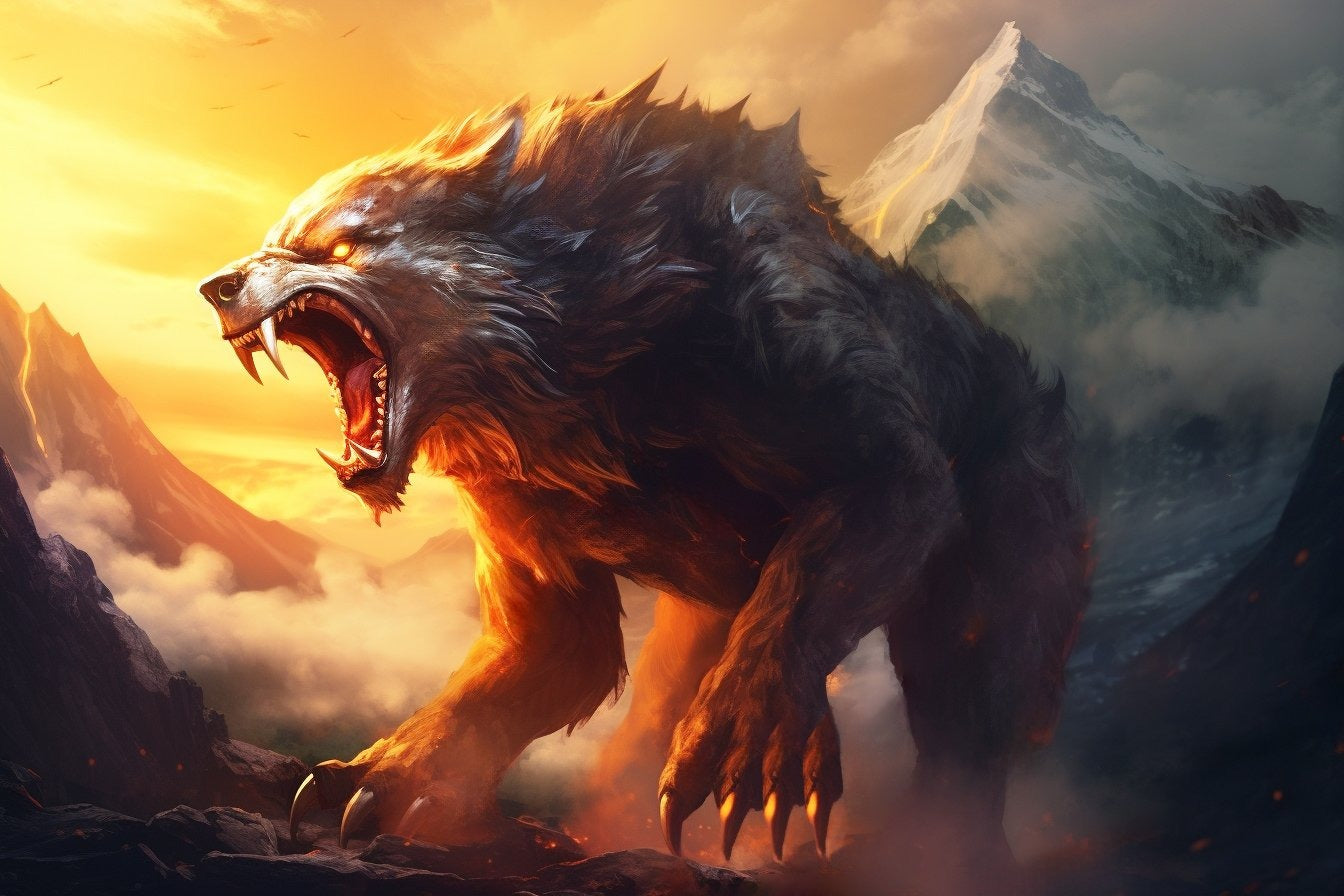Fenrir: The Ferocious Wolf of Norse Mythology

Fenrir: The Ferocious Wolf of Norse Mythology
Fenrir, the monstrous wolf of Norse mythology, is one of the most fearsome and significant figures in the ancient tales of the Vikings. Born of the trickster god Loki and the giantess Angrboda, Fenrir is destined to play a pivotal role in Ragnarok, the end of the world. His story is one of power, prophecy, and the inescapable fate that binds even the gods.
The Birth and Growth of Fenrir
Fenrir was born in Jotunheim, the land of giants, to Loki and Angrboda, along with his siblings Jörmungandr (the Midgard Serpent) and Hel (the ruler of the underworld). From the moment of his birth, Fenrir was feared by the gods due to his immense size and strength. He grew rapidly, becoming more massive and terrifying with each passing day.
The gods, recognizing the danger that Fenrir posed, decided to take action. They brought the wolf to Asgard under the guise of raising him, but their true intention was to keep him under control. Only the god Tyr, known for his bravery, was willing to approach and feed Fenrir, earning the wolf's trust.
The Binding of Fenrir
As Fenrir continued to grow, the gods realized that they could no longer keep him in Asgard. They attempted to bind him with various chains, but Fenrir easily broke each one. Finally, the gods turned to the dwarves, master craftsmen who created a magical ribbon called Gleipnir. Despite its delicate appearance, Gleipnir was made from impossible ingredients, including the sound of a cat's footfall and the roots of a mountain, making it unbreakable.
The gods approached Fenrir with Gleipnir, pretending it was merely a game to test his strength. Fenrir, sensing a trap, agreed to be bound only if one of the gods placed their hand in his mouth as a sign of good faith. Tyr, knowing the consequences, bravely volunteered. Once Fenrir was bound and realized he could not break free, he bit off Tyr’s hand in a fit of rage. The gods then secured Fenrir to a rock far away, placing a sword in his mouth to keep it open, and left him to wait until Ragnarok.
Fenrir’s Role in Ragnarok
According to prophecy, Fenrir’s fate is intertwined with the events of Ragnarok, the apocalyptic battle that will bring about the end of the world. During Ragnarok, Fenrir will break free from his bonds, and his immense size and power will cause the earth to tremble. He will join forces with the giants and other enemies of the gods, leading the charge against Asgard.
Fenrir’s most infamous deed during Ragnarok is his battle with Odin. It is foretold that Fenrir will devour Odin, ending the reign of the Allfather. However, Fenrir will not survive Ragnarok, as Odin’s son Vidar will avenge his father by slaying the wolf.
Symbolism of Fenrir
Fenrir embodies the themes of chaos, destruction, and the inevitability of fate in Norse mythology. His story illustrates the idea that even the gods cannot escape their destiny, no matter how hard they try. Fenrir’s uncontainable strength and ferocity also symbolize the wild, untamable forces of nature, which can be restrained for a time but will eventually break free.
The binding of Fenrir can be seen as a metaphor for the temporary control that societies attempt to exert over chaos and violence, but like Fenrir, these forces can never be truly subdued and will resurface when the time comes. His role in Ragnarok further emphasizes the cyclical nature of Norse mythology, where the destruction of the old world is necessary for the creation of a new one.
Fenrir in Viking Culture
In Viking culture, wolves were both feared and revered as powerful and cunning predators. Fenrir, as the ultimate wolf, represents the awe and terror that these animals inspired. His story was likely told as a cautionary tale about the dangers of unchecked power and the futility of trying to escape one’s fate.
Fenrir’s legacy has persisted into modern times, where he is often depicted in art, literature, and popular culture as a symbol of primal strength and the darker aspects of nature. His image is frequently used in tattoos, jewelry, and other forms of Norse-inspired symbolism to represent power, resilience, and the acceptance of fate.
Modern Interpretations of Fenrir
Today, Fenrir remains a popular figure in various forms of media, from books and movies to video games and comics. He is often portrayed as a powerful and fearsome creature, embodying the primal forces that lie just beneath the surface of the world. In modern pagan and Heathen practices, Fenrir is sometimes invoked as a symbol of strength and the acceptance of inevitable change, representing the necessary destruction that precedes new growth.
While Fenrir’s story is one of darkness and destruction, it also carries the message that even in the face of overwhelming power and inevitable fate, there is a place for courage, as shown by Tyr’s sacrifice, and for the understanding that all things must come to an end to make way for new beginnings.
Conclusion
Fenrir, the monstrous wolf of Norse mythology, is a symbol of untamed power, destruction, and the inevitability of fate. His story, from his birth and binding to his role in Ragnarok, reflects the Norse understanding of the world’s cyclical nature and the inescapable destiny that binds all beings, even the gods. As a figure of both fear and fascination, Fenrir continues to inspire and captivate those who delve into the rich tapestry of Norse mythology.
Fenrir, Norse mythology, Ragnarok, Odin’s wolf, Fenrir prophecy, Gleipnir, Norse wolf symbolism, Viking myths, Norse gods, Fenrir in Ragnarok.
